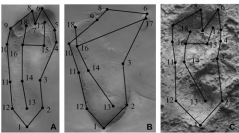

 Comptes Rendus Palevol
5 (3-4) - Pages 561-569
Comptes Rendus Palevol
5 (3-4) - Pages 561-569We compared Laetoli footprints (G1/35-36-37, G3/26) with modern humans (62 footprints), and a chimpanzee walking bipedally (five footprints). Video cameras allowed us to capture walking parameters on a wet clay walkway, and the Procrustes method was used to analyze the footprint shape (outlines and centres of pressure). Like humans, Laetoli hominids walked with small feet gap, and probably low velocity (they used heels as brakes). They preserved certain ape-like traits (foot proportions, roll-off). They also possessed more marked human-like traits (small vault, metatarsal pressure, similar toe-off). Like humans walking on a soft ground, they flexed toes at ground contact, and then propelled themselves by pushing on the ball of the foot and on digits (hallux and lateral toes acting together). The hypothesis of permanently flexed, or curled-underneath, digits was not retained by comparison with the chimpanzee.
Bipedalism, Morphometry, Laetoli, Australopithecus, Pan, Homo